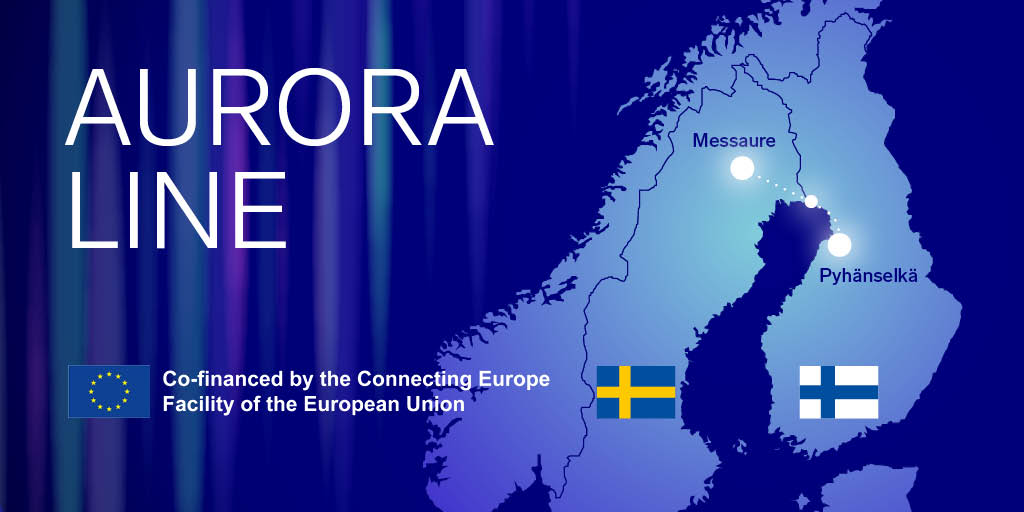What is the Aurora Line?
Fingrid and Svenska Kraftnät are working together to design a new electricity transmission link from Messaure in Northern Sweden to Pyhänselkä to the southeast of Oulu in Finland. The connection will be approximately 380 kilometres long, cost an estimated EUR 250 million and be completed in 2025. Jussi Jyrinsalo, Senior Vice President:
‘The link between Finland and Sweden has frequently been a bottleneck. In such cases, the transmission capacity is insufficient, and the electricity price in Finland rises.’
Why is the Aurora Line needed?
The new transmission link will increase the electricity transmission capacity between Finland and Sweden by 65 per cent. According to Jyrinsalo, this will have many benefits:
- The line will alleviate the bottleneck between Finland and Sweden, thereby decreasing the electricity price in Finland.
- It will reduce CO2 emissions, because it enables even more wind power construction on both sides of the border.
‘Wind power needs other forms of electricity generation to act as a buffer. This is to ensure that the grid can be kept in balance using Nordic hydroelectric power rather than fossil-fuelled electricity from Russia or Estonia.’ - It will improve system security, stabilise the grid, and reduce the impact of disturbances.
From the consumer’s perspective
SSAB aims to become a CO2-free steel company by 2045. The current coal-based blast furnace process will be replaced by a hydrogen reduction process, which requires much more electricity. For example, the annual electricity consumption of the Raahe plant could increase up to tenfold.
The reduction in emissions will take place gradually as the new processes replace the current ones. The first changes will occur this decade. Mikko Lepistö, Energy Manager, SSAB:
‘The new link will stabilise Finland’s electricity market, creating a more stable investment environment and making investments in Finland more attractive.’
‘As consumption increases, it is important that the electricity market operates as efficiently as possible on both sides of the border. For example, there were a lot of regional price differences last year, but the new link will ensure the same price level in different areas.’
Why has this alignment been chosen?
- A conventional power line is both more cost-efficient and better in terms of grid stability than a submarine cable.
- A lot of clean hydroelectric and wind power is generated in Northern Sweden where the line originates, so there is frequently an electricity surplus as well.
- On the Finnish side of the border, the line can be connected to the future Forest Line, which will transmit electricity from the north to areas of high consumption in the south.
Sweden and the Baltic states will also benefit – EU aid for Aurora investments?
The benefits of the Aurora Line will spread beyond Finland, says Jussi Jyrinsalo from Fingrid.
- Sweden will also benefit from a more stable grid and a larger electricity market area, though the electricity price in Northern Sweden has often been lower than in Finland.
- Sweden’s internal electricity transmission links from north to south often suffer from bottlenecks, which the Aurora Line can bypass via Finland.
- The Baltic states often keep the same electricity price level as Finland, so the Aurora Line will also reduce the electricity price in the Baltic states.
However, the Aurora Line is an asymmetrical project: as Finland will enjoy most of the benefits, Fingrid will pay for the majority of the investment on the Swedish side of the border. The total will come to more than EUR 200 million.
‘Although Finnish electricity consumers will benefit most from the project, it will also have wider-ranging advantages for the Baltic Sea region. We hope it will be possible to replace the asymmetrical funding with EU grants.’
What is CEF funding?
The EU has granted CEF funding for the design of the Aurora Line, and Fingrid and Svenska Kraftnät are also applying for a grant for the construction phase.
- Energy networks are one of the three areas covered by the Connecting Europe Facility (CEF).
- The aims are to build the missing links between energy networks and promote clean energy, and the Aurora Line meets these criteria.
- Grants can be awarded for half of the total investment.
What if no grant is awarded?
If no CEF funding is forthcoming, the parties will strive to make the investment anyway. In such a case, Fingrid will use bottleneck and tariff income.
The article has been published in the MustRead newsletter on March 9, 2021.






